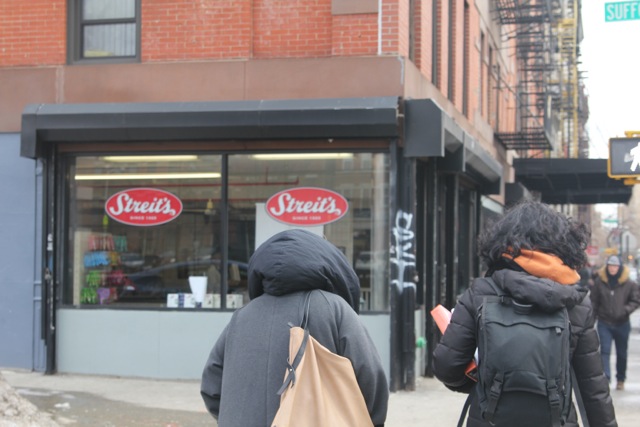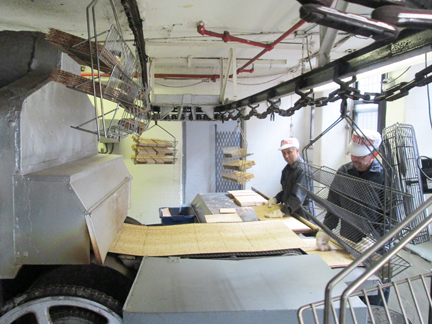On February 12th I gave one of my Jewish food tours of the Lower East Side. I had three people on my tour: one woman who was also a docent for marketplaces in Turkey, one visitor all the way from Australia, and Liz Reuven, a food blogger for Kosher Like Me. After making our way down East Houston Street to have delicious tastes from Yonah Schimmel’s Knishes, Russ & Daughters appetizing shop, and the famous Katz’s Delicatessen, we continued down Rivington Street towards the Streit’s matzah factory. I never am quite sure if Streit’s will be open since the owners are very observant (and there are often small holidays that I don’t even know about!), but that morning we were lucky. As soon as we walked into the store the warm smell of freshly baked matzah greeted us. Directly to the right of the door large, flat squares of perforated matzah were being pushed out of the machine, reminding me of of an old fashioned printing press. And behind the counter was Rabbi Kirshner, warmly welcoming us into the store
and factory.

Window sign at Streit’s matzah factory on the Lower East Side.
Photo by ©Liz Rueven, www.KosherLikeMe.com
Streit’s was first founded by Aron Streit (an immigrant from Austria) and his wife in 1916. The factory was originally set up on Pitt Street on the Lower East Side, but the present location on Rivington Street has been the same since 1925, and is still family owned. Each trip to the factory I learn something new and interesting. For example, the factory looks small since you see only the store and one of the machines upfront, however the factory is actually four buildings wide and several floors high, and where ALL of the Streit’s matzot and other products are produced for all commercial sales. On the shelves you can purchase more than just simple matzah. Red jelly candies called, “Gefilte Fish” hanging in small bags on the wall bring small chuckles from customers, while on the shelves sit a variety of matzah types such as whole wheat, organic, spelt, and egg — all of which reflect the modern palate. Rabbi Kirshner noted that for half of the year they are producing matzah and related products for every day consumption. I was curious about who all of these people were that bought matzah year-round (for me it’s really just something that you do during the week of Passover once a year) and he further went on to explain that there were a number of customers who enjoyed the crispy texture of the matzah, and felt it to be a healthier substitute for crackers and breads since it was low in salt, sugar, and fat. These matzot also contained some added ingredients, such as vegetable oil or seasonings, while the ones made just for Passover time only have flour and water.

Closeup of matzah rolling out of oven.
Photo by ©Liz Rueven, www.KosherLikeMe.com
The preparation of kasher-ing and cleaning the entire factory and machines (to produce matzah that is KLP, or Kasher L’Pesach) began as early as Sukkot, six months before Passover begins (on this morning I noticed that the non-KLP products were on sale by 50% in order to start cleaning the shelves and make way for the KLP ones in mid-March). During this time they meticulously take apart each machine (removing every tiny screw), carry them to the curbside, and clean them in the appropriate fashion before reconstructing the machines again. This is serious stuff, and I thought about the amount of time, money, and dedication it takes to keep this business going. The other very important factor is the preparation of the matzot for Passover. For these you have the rabbis overseeing the production to make sure that the total time that it takes for the matzah ingredients to be mixed together, rolled out, cut, and completely baked must be no more than 18 minutes from begging to end. The understood rule is that it is believed that up until 18 minutes the dough has not had enough time to rise in any way. After 18 minutes the leavening process begins, making the matzah unkosher for Passover consumption. In order to be sure that there is no contamination, the mixers have to be thoroughly cleaned between each batch so as to be sure that there are no small remnants of dough left that could have leavened during that time and affect future batches. I started to shake my head in amazement thinking how exhausting this whole process was. But then I smiled realizing that what made this factory so unique was not simply that it still existed after all of these years on the Lower East Side, but that its owners had been training its staff how to follow the same stringent rituals of producing their matzah as their great-grandparents had. The patient and religious attention to detail is paramount to the quality and integrity of the product, and what it symbolizes. I have had several individuals confide in me that they would never eat matzah any other time of the year because “it tastes like cardboard”. But on Passover, the taste is familiar and delicious. This is because the matzah tells a story of our Hebrew ancestors when they were fleeing from Egypt and did not have enough time to let the dough for their bread rise in the usual way. When you bite into that first piece of matzah on the first night of Passover, you know that the traditions have been kept for centuries, and even as a fairly secular Jew, I respect that dedication to observance. This is the aspect of Jewish food, and particularly Passover food, that I love and want to help keep alive. Without the rigorous attention to detail inherent in these ancient Passover rituals, the matzah would cease to be special, and so would the holiday itself, even to those of us who are less observant.
Here are some links to other things regarding matzah and Streit’s that you might be interested in:




Good day! This is my first visit to your blog! We are a collection of volunteers and starting a new project in a community in the same niche.
Your blog provided us valuable information to work on. You have done a wonderful job!